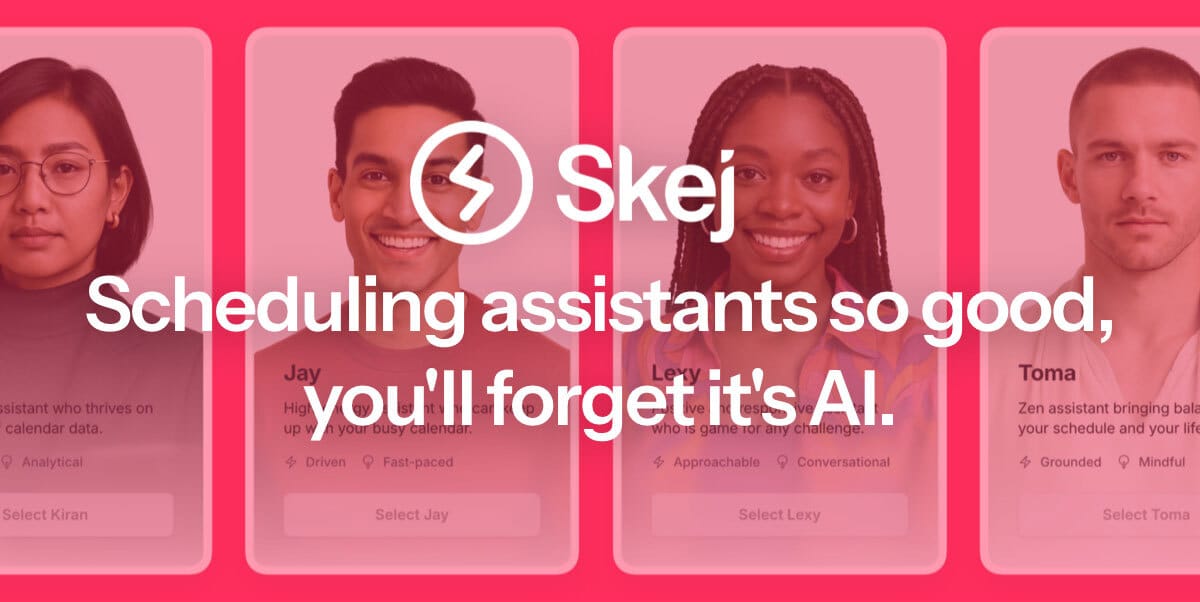- The CyberLens Newsletter
- Posts
- The Evolution of Credential Hacking: Strategies, Statistics, and Defense in the Digital Age
The Evolution of Credential Hacking: Strategies, Statistics, and Defense in the Digital Age
The Silent Breach That Never Sleeps

An AI scheduling assistant that lives up to the hype.
Skej is an AI scheduling assistant that works just like a human. You can CC Skej on any email, and watch it book all your meetings. It also handles scheduling, rescheduling, and event reminders.
Imagine life with a 24/7 assistant who responds so naturally, you’ll forget it’s AI.
Smart Scheduling
Skej handles time zones and can scan booking linksCustomizable
Create assistants with their own names and personalities.Flexible
Connect to multiple calendars and email addresses.Works Everywhere
Write to Skej on email, text, WhatsApp, and Slack.
Whether you’re scheduling a quick team call or coordinating a sales pitch across the globe, Skej gets it done fast and effortlessly. You’ll never want to schedule a meeting yourself, ever again.
The best part? You can try Skej for free right now.

Interesting Tech Fact:
🔍 Did You Know?
In the 1960s, one of the very first credential hacks didn’t come from a cybercriminal at all—it came from a printing error at MIT. The Compatible Time-Sharing System (CTSS) accidentally printed out a list of every user’s login credentials, handing early hackers and curious students unrestricted access. This rare mishap is now remembered as one of the earliest incidents of credential compromise, proving that even decades ago, password security was already a challenge.
Introduction
In cybersecurity, few threats have remained as persistent and devastating as credential hacking. From the earliest brute force password attempts in the 1980s to today’s AI-driven credential stuffing and phishing-as-a-service, this type of attack has not only evolved but scaled into a global cyber-crime industry worth billions. While firewalls, encryption, and endpoint defenses have advanced significantly, credentials—our usernames, passwords, and access keys—remain the weakest link.
CyberLens has examined how credential hacking has transformed over the years, the exact strategic techniques that attackers now employ, the frequency of these attacks, who the primary targets are, and the proactive methods organizations can deploy for prevention. We’ll also dive into a case study that illustrates the scope of the threat and close with a forward-looking reflection on the battle against credential compromise.

The Historical Arc of Credential Hacking
1980s – 1990s: Hackers primarily relied on brute force and dictionary attacks against weak, commonly used passwords. At this stage, targets were mainly hobbyist bulletin board systems (BBS) and university networks.
2000s: With the rise of e-commerce, online banking, and corporate intranets, credentials became a lucrative target. Keyloggers, phishing emails, and password reuse exploits started emerging.
2010s: The explosion of cloud services, social media, and SaaS platforms made credentials an entry point to millions of sensitive accounts. Credential stuffing—where attackers used stolen credentials across multiple services—skyrocketed.
2020s – Present: Credential hacking is now industrialized. Attackers use AI to automate phishing campaigns, dark web marketplaces for purchasing stolen credentials, and advanced proxy services to bypass detection. The integration of post-quantum resistant encryption discussions shows how critical the security landscape has become.
This transformation underscores one simple truth: while technology has advanced, human reliance on passwords has left us in a perpetual game of catch-up with adversaries.

A Visual Representation of Historical Time-Line
Strategic Techniques Hackers Use Today
Credential hacking techniques are not just opportunistic; they are methodical, scalable, and highly engineered. Among the most prevalent are:
Credential Stuffing: Using massive databases of stolen usernames and passwords (from prior breaches) to attempt logins across multiple sites. Attackers exploit password reuse—a habit of over 60% of internet users.
Phishing-as-a-Service (PhaaS): Sophisticated platforms that allow even low-skilled attackers to deploy convincing phishing campaigns with spoofed domains, realistic login portals, and automated credential harvesting.
Password Spraying: Instead of hammering one account with many guesses, attackers try one common password (e.g., “Welcome123”) across thousands of accounts, minimizing lockouts.
Man-in-the-Middle (MitM) Attacks: Attackers intercept credentials during transmission, often via compromised Wi-Fi hotspots, malicious proxies, or DNS spoofing.
Dark Web Credential Marketplaces: Cybercriminals can purchase access credentials at scale, some as cheap as $2 per account, bundled with cookies and session tokens.
AI-Powered Social Engineering: Generative AI tools now produce hyper-personalized spear-phishing emails that bypass traditional filters and exploit psychological trust factors.
The playbook is evolving with automation and artificial intelligence, allowing attackers to operate at a scale that overwhelms traditional defenses.
The Frequency and Scale of Credential Attacks
Statistics reveal the unrelenting scale of credential-based attacks:
According to Verizon’s 2025 Data Breach Investigations Report, over 74% of breaches involve credential misuse.
Akamai reports over 15 billion credential-stuffing attempts daily across its global infrastructure.
Microsoft detected over 4,000 password spray attacks per second on its cloud services in early 2024.
IBM estimates the average cost of a credential-based breach is now $4.62 million per incident, with detection often delayed by 250+ days.
These numbers highlight that credential attacks are not occasional—they are constant, pervasive, and industrialized.
Credential hacking is not random; attackers strategically pursue high-value targets:
Financial Institutions: Online banking credentials remain the holy grail due to direct monetary value.
Healthcare Systems: Patient portals and EHR logins provide access to sensitive data that can be sold or used in fraud.
Government and Critical Infrastructure: Credentials to energy, transportation, and defense systems are attractive for espionage and sabotage.
Remote Workforce Platforms: With the shift to remote work, VPN and collaboration tool credentials (e.g., Zoom, Slack, Teams) are prime attack vectors.
Social Media and Email Accounts: These serve as stepping stones for impersonation, further phishing, and reputational damage.
The democratization of hacking tools means that no organization is too small or obscure to be targeted. SMEs (small and mid-sized enterprises) are increasingly exploited because of their weaker defenses.
Preventive Strategies Against Credential Hacking
🔑 “Lock the Gate Before It’s Picked”
Proactive credential security is not optional—it’s existential.
Organizations and individuals can mitigate credential hacking risks through layered strategies:
Multi-Factor Authentication (MFA): Adding a second layer beyond passwords reduces success rates of stolen credentials by over 99% (Microsoft).
Passwordless Authentication: Biometrics and hardware keys (e.g., YubiKeys) remove the reliance on passwords altogether.
Adaptive Authentication: Using AI and machine learning to detect anomalies (e.g., login from an unusual location or device).
Credential Hygiene: Enforcing strong password policies, educating users about phishing, and mandating regular credential rotation.
Dark Web Monitoring: Proactively scanning for leaked credentials linked to your organization and forcing resets.
Zero Trust Architecture: Assuming no login attempt is inherently trustworthy, requiring continuous verification.
When layered effectively, these defenses turn the economics of hacking upside down, making attacks costly and less scalable.

Case Study: The 2023 Healthcare Credential Breach
In 2023, a major U.S. healthcare provider experienced a devastating breach that originated from compromised employee credentials. The attack unfolded as follows:
Initial Compromise: Attackers purchased a set of employee login details for the provider’s patient portal on a dark web forum for under $30.
Lateral Movement: Using these credentials, attackers accessed internal scheduling software, which lacked MFA, and escalated privileges to administrator accounts.
Data Exfiltration: Over six weeks, attackers extracted 3.2 million patient records, including Social Security numbers and insurance details.
Financial Impact: The provider faced $95 million in regulatory fines and lawsuits, alongside reputational damage and loss of public trust.
Aftermath: Following the incident, the provider implemented passwordless logins, mandatory MFA across all systems, and hired a 24/7 SOC team.
This case illustrates the domino effect of one compromised credential. A single weak entry point snowballed into catastrophic consequences.

Final Thought: Beyond Passwords, Toward a Trustless Future
Credential hacking is not just a technical problem—it is a systemic challenge born of human behavior, economic incentives, and legacy infrastructure. Attackers exploit the weakest links in both technology and psychology, scaling their efforts with AI and automation.
If history teaches us anything, it’s that passwords alone will never be enough. The future lies in passwordless authentication, zero trust ecosystems, and AI-driven anomaly detection. The organizations that survive this digital war will be those that recognize security not as a checkbox but as a continuous adaptive process.
At its core, defending against credential hacking is not about outspending attackers—it’s about outthinking them. By embracing layered defenses, continuous education, and forward-looking strategies, enterprises can shift from being reactive victims to proactive defenders.
And yet, the battle will never be “won” in the traditional sense. As long as credentials exist, they will be hunted. The challenge for the cybersecurity community is to innovate faster than adversaries, creating a future where stolen credentials lose their value.
The choice is clear: Evolve beyond the password or remain trapped in a cycle of compromise.

Subscribe to The CyberLens Newsletter
Cybersecurity isn’t just about firewalls and patches anymore — it’s about understanding the invisible attack surfaces hiding inside the tools we trust.
CyberLens brings you deep-dive analysis on cutting-edge cyber threats like model inversion, AI poisoning, and post-quantum vulnerabilities — written for professionals who can’t afford to be a step behind.
📩 Subscribe to The CyberLens Newsletter today and Stay Ahead of the Attacks you can’t yet see.







